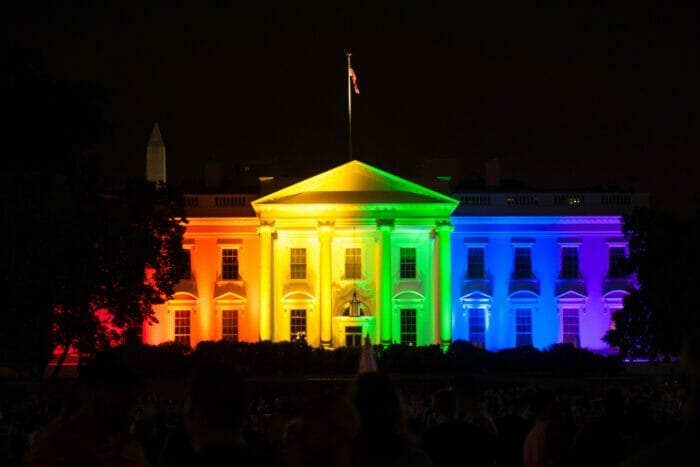
Although LGBTQ pride and its annual June celebration have become more visible in mainstream culture over the past ten years or so, the history of discrimination against LGBTQ people in the immigration context goes back more than a century.
As early as 1917, federal law specifically restricted immigration by individuals who showed signs of what Congress called “constitutional psychopathic inferiority,” a classification that was also used to discriminate against people based on their sexual orientation. The law was used to prevent LGBTQ people from immigrating to the United States, even when they faced persecution in their home country.
Those who were able to come to the U.S., however, worked to create a more inclusive and equal society. The country’s first LGBTQ organization, the Society for Human Rights, was founded by military veteran and Bavarian immigrant Henry Gerber Chicago, Illinois in 1924. These early efforts to organize the LGBTQ community increased its visibility, planting the seeds for the future, formal LGBTQ rights movement that is generally considered to have begun with the Stonewall Rebellion in New York in 1969.
Post-war America saw the rise not only of the Red Scare, but also a lesser known “lavender scare” in which the federal government launched a “Pervert Elimination Campaign.” This discriminatory policy resulted in the arrests, firings, and general social persecution of LGBTQ Americans working for the federal government. This anti-LGBTQ sentiment spilled over into the broader culture as well, causing concern among LGBTQ individuals working in different industries across the country.
The government’s anti-LGBTQ attitudes were insidious, and found their way into immigration policy as well. The 1952 Immigration and Nationality Act upheld the controversial national origins quota system that had been established in 1924, despite President Harry Truman’s opinion that the law was racist and discriminatory. In addition to reinforcing the national origins quota, the 1952 INA also instituted new, anti-Communist and anti-LGBTQ laws preventing people from entering the country or obtaining green cards or citizenship. The INA referred to LGBTQ people as “aliens afflicted with a psychopathic personality, epilepsy or mental defect.”
The Immigration and Nationality Act of 1965, while it reversed the national origin quota system, became the first policy to explicitly prevent “sexual deviates” from entering the country under the guise of a medical exclusion. The Act also required the legacy Immigration and Naturalization Service (INS, now subsumed by the Department of Homeland Security) to deport LGBTQ people.
This policy was not reformed until the Immigration Act of 1990, when sexual orientation was finally removed as a grounds of exclusion from the U.S. However, the ban on HIV/AIDS-positive individuals from entering the U.S., which was signed into law by President Ronald Reagan in 1987, remained in effect until 2010. HIV/AIDS disproportionately affected the LGBTQ community in the 1980s, making the bans particularly harmful to LGBTQ migrants even after the ban on entry due to sexual orientation was lifted.
During the 1980s and 1990s, the U.S. also began to ramp up detention of unauthorized immigrants, as well as deportations. The 1987 INS Detention Officer Handbook emphasized that “violations against the law or public morality, including murder, stealing, forgery, sodomy, bestiality, homosexuality, drug peddling, drunkenness, gambling, and subversion,” were punishable offenses. Government staff working in the detention centers sequestered “deviant” prisoners, preventing them from having access to the rest of the detention facility. These policies made immigration detention a potentially violent and dangerous place for LGBTQ migrants. As recently as 2018, the Center for American Progress found that LGBTQ immigrants held at federal detention centers are 97 times more likely to be sexually assaulted than other detainees.
The first asylum case granted in the U.S. on the basis of persecution bdue to sexual orientation was not until 1994; ironicially, two years later Congress passed the Defense of Marriage Act (DOMA), which openly discriminated against same-sex married couples by denying them access to marriage-based federal benefits, including the ability to sponsor a spouse for a green card. It was not until the Supreme Court struck down as unconstitutional part of DOMA in 2013 that same-sex couples could petition for their partners and family members in the same manner as other couples.
In 2015, the Supreme Court ruled that same-sex marriage is protected by the Constitution as a fundamental right. The case, Obergefell v. Hodges, guaranteed the right of marriage as a “keystone of our social order” that is required for LGBTQ couples to receive “equal dignity in the eyes of the law.”
Though the LGBTQ movement has made rapid strides towards greater freedom and equality in the past several decades, the corresponding immigration laws have been slow to catch up. The recent wave of anti-transgender legislation being discussed and enacted in various states of the country also bodes ill for LGBTQ immigrants. And with the leaked Supreme Court opinion overturning Roe v. Wade, some fear that rights for LGBTQ people could be the next to go, with the consequences for LGBTQ immigrants and their families being particularly severe.